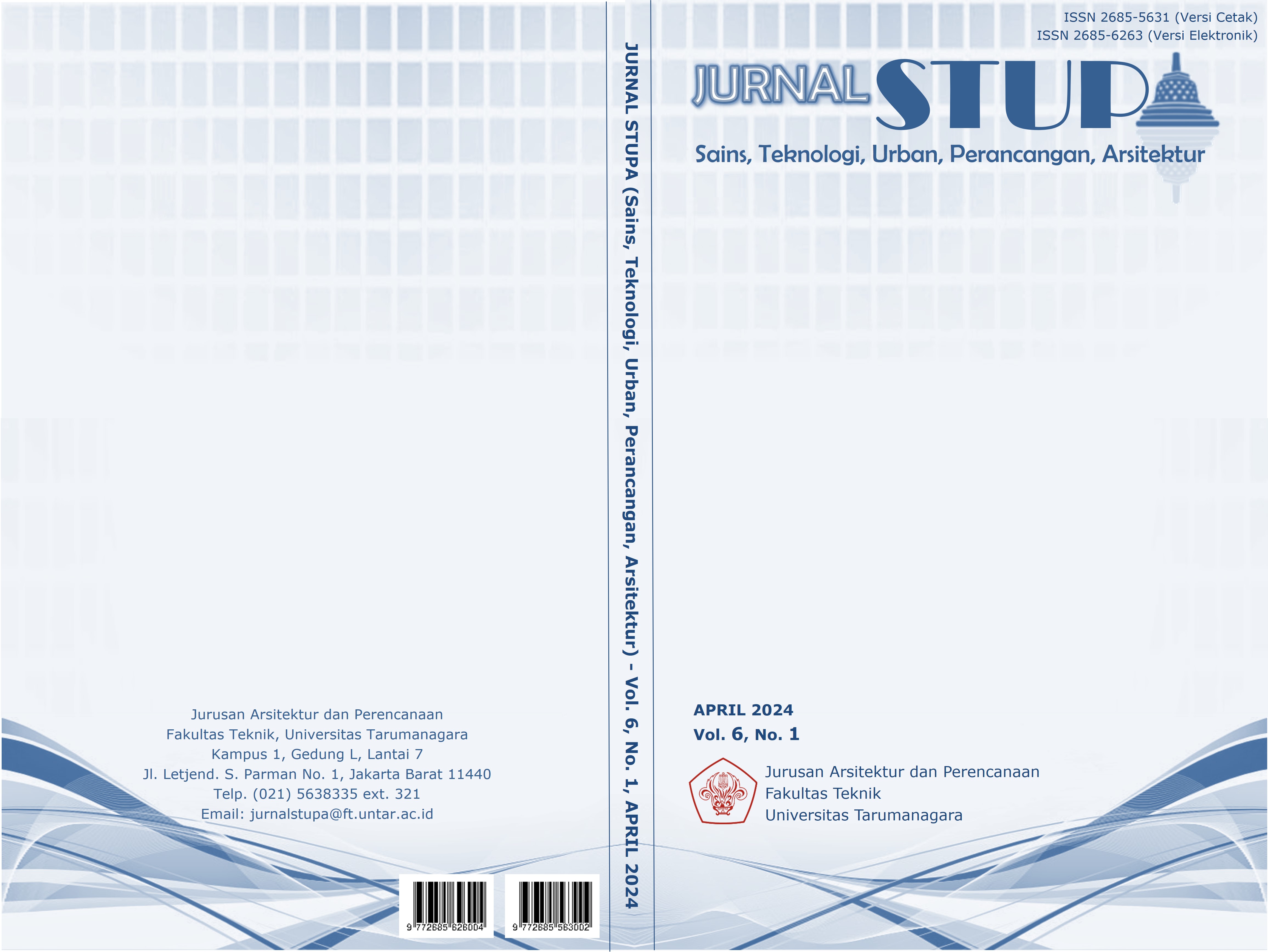PENERAPAN TERAPI KREATIF DAN ARSITEKTUR TERAPEUTIK DALAM MENCIPTAKAN “TEMPAT KETIGA” BAGI REMAJA UNTUK MEMPROSES DUKA
Main Article Content
Abstract
Adolescence is a critical phase in identity formation, shaping the direction for individuals transitioning to adulthood. The primary challenge is overcoming identity confusion arising from the failure to discover one's identity. Grief experiences, especially due to death or relationship breakups, significantly impact the mental health of adolescents, increasing the risk of issues such as anxiety and depression. Comprehensive support is crucial to assist adolescents in coping with traumatic experiences and fostering their development. The main focus of this research is to aid adolescents in dealing with grief, particularly after losing someone, facilitating grief processing, and supporting identity development and intimacy processes in the late adolescent phase. The research employs qualitative methods, including observation, analysis, documentation, and interviews, to explore the impact of grief on adolescents, especially when losing a loved one. The subjects are adolescents in Jakarta, with the participation of psychologists as contributors. The research aims to guide the creation of architectural spaces that support adolescents in facing the grieving process. The findings indicate that grief therapy interventions for adolescents, using methods like writing trauma narratives, journaling, and engaging in artistic activities, play a crucial role. The concept of a third place, re-mapping relationship patterns, and integrating therapeutic architecture is revealed as an effective approach to supporting adolescent recovery. The combination of creative therapy and therapeutic architectural approaches creates an environment that supports adolescents in managing the experience of loss while considering their developmental needs.
Keywords: adolescent; creative theraphy; grief; remapping; third place
Abstrak
Masa remaja merupakan fase kritis dalam pembentukan identitas, menentukan arah bagi individu menuju dewasa. Tantangan utama adalah mengatasi kebingungan identitas yang muncul dari kegagalan menemukan identitas. Pengalaman duka, terutama kematian atau putusnya hubungan, signifikan terhadap kesehatan mental remaja, meningkatkan risiko masalah seperti kecemasan dan depresi. Dukungan komprehensif penting untuk membantu remaja mengatasi pengalaman traumatis dan mendukung perkembangan mereka. Fokus utama penelitian ini adalah membantu remaja mengatasi duka, terutama setelah kehilangan seseorang, memfasilitasi pemrosesan kedukaan, dan mendukung perkembangan identitas serta proses intimasi pada fase remaja akhir. Penelitian menggunakan metode kualitatif dengan observasi, analisis, dokumentasi, dan wawancara untuk mengeksplorasi dampak kedukaan pada remaja, terutama saat kehilangan orang yang dicintai. Subjeknya adalah remaja di Jakarta, dengan partisipasi psikolog sebagai narasumber. Penelitian bertujuan mengarahkan pembentukan wadah arsitektur yang mendukung remaja dalam menghadapi proses kedukaan. Hasil penelitian menunjukkan bahwa intervensi terapi kedukaan pada remaja, dengan metode seperti menulis narasi trauma, menjalani jurnal, dan terlibat dalam kegiatan seni, memiliki peran krusial. Konsep tempat ketiga, pemetaan ulang pola hubungan, dan integrasi terapeutik arsitektur diungkapkan sebagai pendekatan efektif untuk mendukung pemulihan remaja. Kombinasi terapi kreatif dan pendekatan arsitektur terapeutik menciptakan lingkungan yang mendukung bagi remaja dalam mengelola pengalaman kehilangan dengan memperhatikan perkembangan mereka.
Article Details

This work is licensed under a Creative Commons Attribution-NonCommercial-ShareAlike 4.0 International License.
This work is licensed under a Jurnal Sains, Teknologi, Urban, Perancangan, Arsitektur/ STUPA Creative Commons Attribution-NonCommercial-ShareAlike 4.0 International LicenseReferences
Cohen, J. A., & Mannarino, A. P. (2004). Treatment of Childhood Traumatic Grief. Journal of Clinical Child and Adolescent Psychology, 819–831.
Corr, C. A., & McNeil, J. N. (1986). Adolescence and Death. Springer Publishing Co.
Edgar-Bailey, M., & Kress, V. E. (2010). Resolving child and adolescent traumatic grief: Creative techniques and interventions. Journal of Creativity in Mental Health, 5(2), 158-176.
Engel, G. L. (1964). Grief and grieving. AJN The American Journal of Nursing, 64(9), 93-98.
Erikson, E. (1968). Identity youth and crisis. New York: W. W. Norton Company.
Erikson, E. H. (1994). Identity and the life cycle. Chicago: WW Norton.
Ernstmeyer, K., Christman, E., Anthon, L., Blohm, L., Brown, B., Christman, E., Sigler, J. (2016). Nursing Fundamentals. Wisconsin: Chippewa Valley Technical College.
Feigelman, W., Rosen, Z., Joiner, T., Silva, C., & Mueller, A. S. (2017). Examining longer-term effects of parental death in adolescents and young adults: Evidence from the national longitudinal survey of adolescent to adult health. Death studies, 41(3), 133-143.
Fernandez, J. (n.d.). Remapping Grief. Retrieved from California Center for Change. Retrieved from https://www.cacenterforchange.com/blog/remapping-grief#:~:text=Re%2Dmapping%20the%20Dimensions%20and%20Coping%20with%20Grief&text=According%20to%20neuroscience%2C%20the%20best,to%20%E2%80%9Clocate%E2%80%9D%20this%20person.
Gladkova, A. (2010). Sympathy, compassion, and empathy in English and Russian: A linguistic and cultural analysis. Culture & Psychology, 16(2), 267-285.
Huberman, A. (2022, Mei 30). The Science & Process of Healing from Grief | Huberman Lab Podcast #74. Retrieved from Online Video Clip: https://www.youtube.com/watch?v=dzOvi0Aa2EA&t=1809s
J., M. F., P., K. A., & Hadinoto, S. R. (2019). Psikologi perkembangan: pengantar dalam berbagai bagiannya. Yogyakarta: Gadjah Mada University Press.
Jahja, Y. (2011). Psikologi perkembangan. In Y. Jahja, Psikologi perkembangan (p. 219). Jakarta: Kencana.
Jeffrey, D. (2016). Empathy, sympathy and compassion in healthcare: Is there a problem? Is there a difference? Does it matter?, Journal of the Royal Society of Medicine, 109(12), 446-452.
Little, L., Fitton, D., Bell, B. T., & Toth, N. (Eds.). (2016). Perspectives on HCI research with teenagers. Berlin: Springer.
Mediastika, C. E. (2016). Understanding empathic architecture. Journal of architecture and Urbanism, 40(1), 1-1.
Oldenburg, R. (1989). The Great Good Place. Cambridge: Da Capo Press.
Pallasmaa, J., Mallgrave, H. F., Robinson, S., & Gallese, V. (2015). Architecture and empathy. Finland: Tapio Wirkkala Rut Bryk Foundation.
Papalia, D. E., & Martorell, G. (2021). Experience Human Development 14th Edition. New York: McGraw-Hill Education.
Pham, S., Porta, G., Biernesser, C., Walker Payne, M., Iyengar, S., Melhem, N., & Brent, D. A. (2018). The burden of bereavement: Early-onset depression and impairment in youths bereaved by sudden parental death in a 7-year prospective study. American Journal of Psychiatry, 175(9), 887-896.
Pop-Jordanova, N. (2021). Grief: Aetiology, symptoms and management. prilozi, 42(2), 9-18.
Shear, M. K. (2012). Grief and mourning gone awry: pathway and course of complicated grief. Dialogues in clinical neuroscience, 14(2), 119-128.



